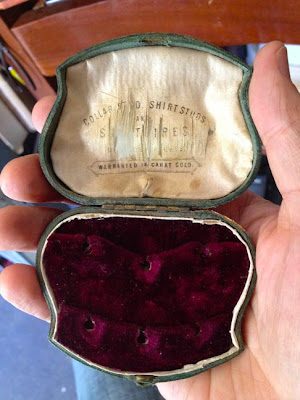Now that my title brass plate is looking as I'd like it, I can put it aside and turn towards modifying the shirt-stud box.
The top chamber's fabric is gently lifted away. I'll be saving this for something else in the future, perhaps.
I'm fascinated to expose the hand-carved wood which hasn't seen daylight in almost 150 years. This was truly from a time when most everything was hand-fashioned.
A circle is scratched into the leather covering...
...then cut from the wood to allow a lens to be fitted.
A gorgeous old science-instrument lens is chosen, with an amazing geometric mirrored focusing hairline.
Now the bottom velvet is eased out. Not sure if I'll use this or not just yet.
Here's another quiet delight - the backing material for the velvet panel sports a fragment of mid-19th-century ledger paper. Yum. I ponder all the millions of hidden fragments that lie dormant behind old picture frames, inside book bindings, etc. This little discovery really thrills me.
The inside of the box exposed. Now it's a blank canvas, just waiting.
Returning to the cello bridge, I inlay a lovely layer of paua shell laminate and grind down the diameter of two small lenses to fit the lower openings.
Checking out the fit and feel.
As I return to the fork and prepare to bend the tines, I make two decisions: 1) the fork itself will be the element that holds the whole piece in the open position, and 2) from it will be suspended a small mobile.
The tines ready.
Off to my storage bits and pieces to find just the right material to fill the box. I find and settle on a spectacular 1787 book cover whose intricate marbleized end paper is perfect.
Cutting out the shape.
The hole in the center will be barely visible behind the lens.
Checking out the order of things...
Now the interior is built up. Horseshoe crab spines encircle the opening.
In preparation for attaching the lens to the outside of the box, I wax up some heavy 1920's Irish linen thread.
Threading it into place.

The spines and book cover as seen through the lens.
The faces to peer from behind all three lenses are chosen from my archives.
The engravings in place and drying.
Now strips of text are cut to rim the interior of the magnified space. The man is peering at a green chalcedony, but I decide to replace it with a more subtle organic object:
The whole assembly in place and finished.
With the inner chambers complete up top, the piece awaits the bottom treatment.
Next week, the bottom of the box is addressed, the mobile is created for the front, and the hanging chain or cord is configured, putting the finishing touches on A Question of Gravity. Please join me for the home stretch.
Keith





























































